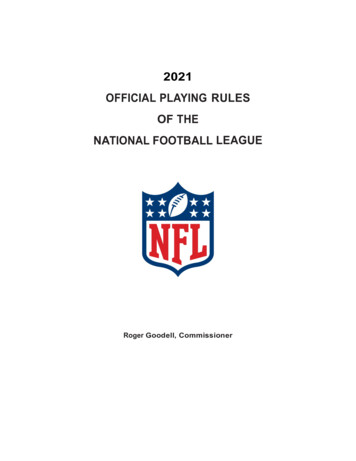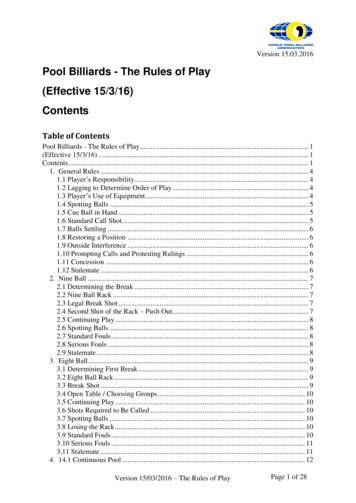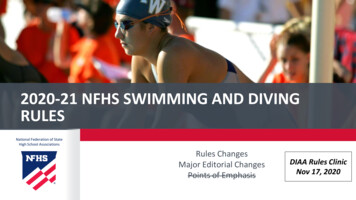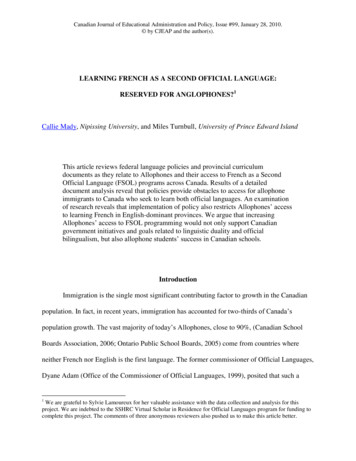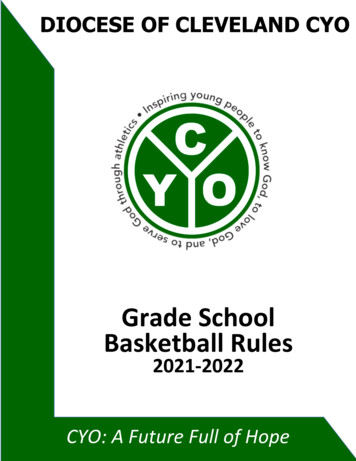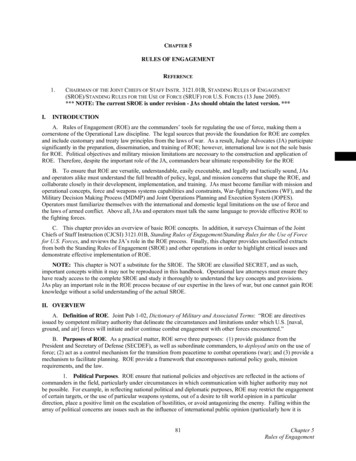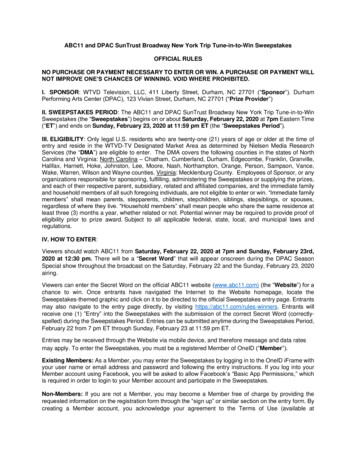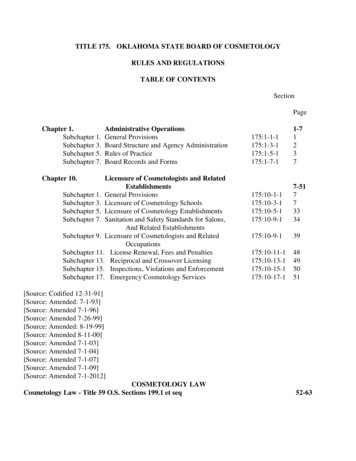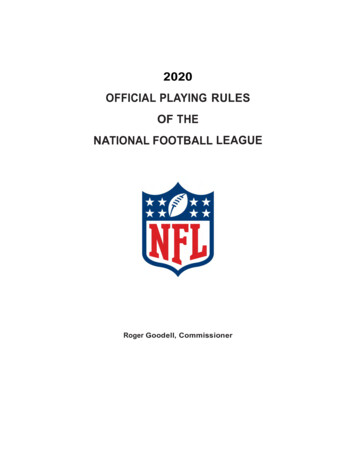
Transcription
2020OFFICIAL PLAYING RULESOF THENATIONAL FOOTBALL LEAGUERoger Goodell, Commissioner
2020 Rules ChangesRule-Section-Article4-3-2Modifies fouls that cause the clock to start on the snap.12-2-9Modifies defenseless player protection for players fielding a kick.14-4-8Allows certain fouls to be enforced on missed field-goal attempts.15-2-4, 15-3-2Modifies requirements for awarding ball following replay review.
PREFACEThis edition of the Official Playing Rules of the National Football League contains all currentrules governing the playing of professional football that are in effect for the 2020 NFL season.Member clubs of the League may amend the rules from time to time, pursuant to the applicablevoting procedures of the NFL Constitution and Bylaws.Any intra-League dispute or call for interpretation in connection with these rules will be decidedby the Commissioner of the League, whose ruling will be final.Because inter-conference games are played throughout the preseason, regular season, andpostseason in the NFL, all rules contained in this book apply uniformly to both the Americanand National Football Conferences.Where the word “illegal” appears in this rule book, it is an institutional term of art pertaining strictlyto actions that violate NFL playing rules. It is not meant to connote illegality under any public lawor the rules or regulations of any other organization.The word “flagrant,” when used here to describe an action by a player, is meant to indicate thatthe degree of a violation of the rules—usually a personal foul or unnecessary roughness—isextremely objectionable, conspicuous, unnecessary, avoidable, or gratuitous. “Flagrant” inthese rules does not necessarily imply malice on the part of the fouling player or an intention toinjure an opponent.Copyright 2020 by the National Football League. All rights reserved.Printed in the United States of America.
ORDER OF THE RULESRulePage1The Field12The Ball33Definitions44Game Timing125Players, Substitutes, Equipment, General Rules186Free Kicks247Ball in Play, Dead Ball, Scrimmage278Forward Pass, Backward Pass, Fumble319Scrimmage Kick3710Opportunity to Catch a Kick, Fair Catch4111Scoring4312Player Conduct4713Non-Player Conduct5614Penalty Enforcement5815Instant Replay6416Overtime Procedures6817Emergencies, Unfair Acts7018Guidelines for Captains7219Officials73Penalty Summary74Official Signals76Table of Foul Codes, Team Abbreviations82Index83
RULE 1SECTION 1THE FIELDDIMENSIONSARTICLE 1. PLAYING LINES. The game shall be played upon a rectangular field, 360 feet in length and 160 feet in width. Thelines at each end of the field are termed End Lines. Those on each side are termed Sidelines. Goal Lines shall be established inthe field 10 yards from and parallel to each end line. The area bounded by goal lines and sidelines is known as the Field of Play.The surface of the entire Field of Play must be a League-approved shade of green. The areas bounded by goal lines, end lines,and sidelines are known as the End Zones.The areas bounded by goal lines and lines parallel to, and 70 feet 9 inches inbounds, from each sideline, are known as the SideZones. The lines parallel to sidelines are termed Inbound Lines. The end lines and the sidelines are also termed Boundary Lines.ARTICLE 2. FIELD.The Field includes the Field of Play and the End Zones. The Field will be rimmed by a solid white border a minimum of 6 feet widealong the end lines and sidelines. An additional broken limit line 6 feet further outside this border is to encompass the Field in thenon-bench areas, and such broken line will be continued at an angle from each 32-yard line and pass behind the bench areas (allbenches a minimum 30 feet back from the sidelines). In addition, within each bench area, a yellow line 6 feet behind the solidwhite border will delineate a special area for coaches, behind which all players, except one player charting the game, must remain.If a club’s solid white border is a minimum of 12 feet wide, there is no requirement that the broken restraining line also be addedin the non-bench areas. However, the appropriate yellow line described above must be clearly marked within the bench areas.In special circumstances (for example, an artificial surface in a multi-purpose stadium) and subject to prior approval from theLeague Office, a club may omit the 6-foot solid white border during the preseason or later period while football overlaps withanother sport, and substitute a single 4-inch white line at what normally would be the outer limit of the solid border (6 feet from thesidelines).SECTION 2MARKINGSARTICLE 1. LINE MARKINGS. At intervals of 5 yards, yard lines (3-12-9) parallel to the goal lines shall be marked in the field ofplay. These lines are to stop 8 inches short of the 6-foot solid border. The 4-inch wide yard lines are to be extended 4 inchesbeyond the white 6-foot border along the sidelines. Each of these lines shall be intersected at right angles by short lines 70 feet,9 inches long (23 yards, 1 foot, 9 inches) in from each side to indicate inbound lines.ARTICLE 2. INBOUND LINES. In line with the Inbound Lines there shall be marks at 1-yard intervals between each distance of5 yards for the full length of the field. These lines are to begin 8 inches from the 6-foot solid border and are to measure 2 feet inlength.Bottoms of numbers indicating yard lines in multiples of 10 must be placed beginning 12 yards in from each sideline. These areto be 2 yards in length.Two yards from the middle of each goal line and parallel to it, there shall be marked in the Field of Play, lines 1 yard in length.All boundary lines, goal lines, and marked lines are to be continuous lines. These, and any other specified markings, must be inwhite, and there shall be no exceptions without the authorization of the Commissioner. Field numerals must also be white.Care must be exercised in any end-zone marking or decoration or club identification at the 50-yard line that said marking ordecorations do not in any way cause confusion as to delineation of goal lines, sidelines, and end lines. Such markings ordecorations must be approved by the Commissioner.The four intersections of goal lines and sidelines must be marked, at inside corners, by weighted pylons. In addition, two suchpylons shall be placed on each end line (four in all).ARTICLE 3. GOAL LINE. All measurements are to be made from the inside edges of the line marking the boundary lines. Eachgoal line marking is to be in its end zone so that the edge of the line toward the field of play (actual goal line) is 30 feet from theinside edge of the end line. Each goal line is to be eight inches wide.All lines are to be marked with a material that is not injurious to eyes or skin. It is desirable that the yard line markers be flexiblein order to prevent injury. No benches or rigid fixtures should be nearer than 10 yards from sidelines.ARTICLE 4. GROUND RULES. In League parks where ground rules are necessary, because of fixed conditions that cannot bechanged, they will be made by the Commissioner.SECTION 3GOALARTICLE 1. CROSSBAR. In the plane of each end line, there shall be a centrally placed horizontal crossbar 18 feet, 6 inches inlength, the top face of which is 10 feet above the ground. The goal is the vertical plane extending indefinitely above the crossbarand between the lines indicated by the outer edges of the goal posts.ARTICLE 2. GOAL POSTS. All goal posts will be the single-standard type, offset from the end line and bright gold in color. Theuprights will extend 35 feet above the crossbar and will be no less than 3 inches and no more than 4 inches in diameter. Anorange-colored ribbon 4 inches by 42 inches is to be attached to the top of each post.Note: Goal posts must be padded in a manner prescribed by the League.SECTION 4PLAYERS’ BENCHESAt the option of the home team, both the players’ benches may be located on the same side of the field. In such a case, the endof each bench shall start at the 45-yard line and continue towards the adjacent goal line.1
Rule 1Note: When both benches are so located, the chain crew and linespersons are to operate during the entire game on theopposite side to the benches.SECTION 5CHAIN CREW AND BALL BOYS/GIRLSMembers of the chain crew and the ball boys/girls must be uniformly identifiable as specified by the Commissioner. White shirtsare to be worn by members of the chain crew.SECTION 6SIDELINE MARKERSThe home club must provide and use the standard set of sideline markers that have been approved by the Commissioner.2
RULE 2SECTION 1THE BALLDIMENSIONSThe Ball must be a “Wilson,” hand selected, bearing the signature of the Commissioner of the League, Roger Goodell.The ball shall be made up of an inflated (12½ to 13½ pounds) urethane bladder enclosed in a pebble grained, leather case (naturaltan color) without corrugations of any kind. It shall have the form of a prolate spheroid and the size and weight shall be: long axis,11 to 11¼ inches; long circumference, 28 to 28½ inches; short circumference, 21 to 21¼ inches; weight, 14 to 15 ounces.The Referee shall be the sole judge as to whether all balls offered for play comply with these specifications. A pump is to befurnished by the home club, and the balls shall remain under the supervision of the Referee until they are delivered to the ballattendant just prior to the start of the game.SECTION 2SUPPLYEach team will make 12 primary and 12 backup balls available for testing by the Referee no later than two hours and 30 minutesprior to the starting time of the game to meet League requirements. For all games, six new footballs, sealed in a special box andshipped by the manufacturer to the Referee, will be opened in the officials’ locker room two hours and 15 minutes prior to thestarting time of the game. These balls are to be specially marked by the Referee and used exclusively for the kicking game.In the event a home team ball does not conform to specifications, or its supply is exhausted, the Referee shall secure a properball from the visitors and, failing that, use the best available ball. Any such circumstances must be reported to the Commissioner.In case of rain or a wet, muddy, or slippery field, a playable ball shall be used at the request of the offensive team’s center.The Game Clock shall not stop for such action (unless undue delay occurs).Note: It is the responsibility of the home team to furnish playable balls at all times by attendants from either side of the playingfield.3
RULE 3DEFINITIONSSECTION 1APPROVED RULING (A.R.)An Approved Ruling (A.R.) is a written decision on a given statement of facts and serves to illustrate the intent and application ofa rule. Supplemental notes are used to amplify a rule. A Note is more specific and applies to a particular situation. It is also usedto indicate pertinent references to other rules.An Official Ruling (O.R.) is a ruling made in the interim between the annual rules meetings and is official only during the currentseason.Technical Terms are such terms that have a fixed and defined meaning throughout the Playing Rules. Because of their alphabeticalarrangement in Rule 3, certain ones are used prior to being defined. In such cases, they appear in bold type only the first timethey are used.SECTION 2THE BALL AND POSSESSION OF THE BALLARTICLE 1. DEAD BALL. A Dead Ball is one that is not in play. The time period during which the ball is dead is Between Downs.This includes the interval during all timeouts, including intermission, and from the time the ball becomes dead until it is legally putin play.ARTICLE 2. BALL READY FOR PLAY. A Dead Ball is Ready for Play while the 40-second Play Clock is running when the ballis placed down by an official at the spot where the ball will next be put in play, or when the Referee signals for the 25-second PlayClock to start.ARTICLE 3. LIVE BALL. A Live Ball is a ball that is in play. A Dead Ball becomes a live ball when it is:(a) legally kicked on a Free Kick Down (6-1-1; 6-1–3);(b) legally snapped on a Scrimmage Down (7-1-1; 7-3–6); or(c) legally kicked on a Fair Catch Kick Down.It continues in play until the down ends (3-9-1).ARTICLE 4. LOOSE BALL. A Loose Ball is a live ball that is not in player possession, i.e., any ball that has been kicked, passed,or fumbled. A Loose Ball is considered to be in possession of the team (offense) whose player kicked, passed, or fumbled it. It isa Loose Ball until a player secures possession or until the ball becomes dead. If it has not yet struck the ground, a Loose Ball isIn Flight.ARTICLE 5. FUMBLE. A Fumble is any act, other than passing, successful handing, or legally kicking the ball, which results in aloss of player possession. It is not a fumble if the player immediately regains control of the ball. The use of the term Fumble alwaysmeans that the ball was in possession of a player when the act occurred (8-7-3).Note: An intentional fumble that causes the ball to go forward is a forward pass and may be illegal (8-1-1-Pen. a–c).ARTICLE 6. MUFF. A Muff is the touching of a loose ball by a player in an unsuccessful attempt to obtain possession of it.Note: Any ball intentionally muffed forward is a bat and may be a foul (3-3; 12-5-1; 3-15).Touching the Ball refers to any contact with the ball. There is no distinction between a player touching the ball with his hands, orwith any other part of his body, including his hair, except as specifically provided for (9-2-2).Note: The result of the touching is sometimes influenced by the intent or the location.(a)(b)(c)(d)See 6-1-4 and 6-2-4 for touching a free kick.See 6-2-3 for touching a free kick before it goes out of bounds between the goal lines.See 8-1-8 for ineligible offensive player touching a forward pass on, behind, or beyond the line.See 9-2-1, 9-3-1 for touching a scrimmage kick on or behind the line, and also 9-2-4 for being pushed into a kick by anopponent.(e) See 11-4-2 for touching a kick during an attempted field goal.(f) Simultaneous touching by two opponents in an attempt to establish possession of a ball that has been kicked is treated as afirst touch by the kicking team.ARTICLE 7. PLAYER POSSESSION.A player is in possession when he is inbounds and has control of the ball with his hands or arms.To gain possession of a loose ball that has been caught, intercepted, or recovered, a player (a) must have complete control of theball with his hands or arms and (b) have both feet or any other part of his body, other than his hands, completely on the groundinbounds, and, after (a) and (b) have been fulfilled, perform any act common to the game (e.g., tuck the ball away, extend itforward, take an additional step, turn upfield, or avoid or ward off an opponent). It is not necessary that he commit such an act,provided that he maintains control of the ball long enough to do so. This rule applies in the field of play, at the sideline, and in theend zone.Notes:(1) Movement of the ball does not automatically result in loss of control.(2) If a player who has completed the first two, but not the third requirement for possession, contacts the ground and losescontrol of the ball, there is no possession if the ball hits the ground before he regains control, or if he regains control outof bounds. If a player would have caught, intercepted, or recovered a ball inbounds, but is carried out of bounds, playerpossession will be granted (8-1-3-Note 5).The terms catch, intercept, recover, advance, and fumble denote player possession (as distinguished from touching or muffing).4
Rule 3A catch is made when a player inbounds secures possession of a pass, kick, or fumble that is in flight. An interception is madewhen an opponent who is inbounds catches a forward or backward pass or a fumble that has not touched the ground.Notes:(1) It is a catch, or an interception, if, in the process of attempting to possess the ball, a player secures control of the ballprior to it touching the ground, and that control is maintained during and after the ball has touched the ground.(2) In the field of play, if a catch or interception has been completed, and the ball comes loose before the player is down bycontact, it is a fumble, and the ball remains alive. It is also a fumble if the action occurs in the end zone of the player whocaught the loose ball. If the action occurs in the opponent’s end zone, it is a touchdown or a touchback.(3) If there is any question by the covering official(s) as to whether a forward pass is complete, intercepted, or incomplete, italways will be ruled incomplete.A recovery is made when a player inbounds secures possession of a loose ball after it has touched the ground.If a Loose Ball is controlled simultaneously by two opponents, and both players retain it, it is simultaneous possession, and theball belongs to the team last in possession, or to the receiving team when there has been a Free Kick, Scrimmage Kick, or FairCatch Kick. It is not simultaneous possession if a player gains control first and an opponent subsequently gains joint control.SECTION 3BATA Bat is the intentional striking of the ball with any part of the hand or arm. See 12-5-1.SECTION 4BLOCKINGBlocking is the act of obstructing or impeding an opponent by contacting him with a part of the blocker’s body.A Block in the Back is a block that is delivered from behind an opponent above his waist. It is not a block in the back:(a) if a player is making a personal attempt to recover a loose ball;(b) if the opponent turns away from the blocker when contact is imminent;(c) if both of the blocker’s hands are on the opponent’s side. (If either hand is on the back, it is a foul.)A Block Below the Waist is when the initial contact with any part of the blocker’s body is below the waist of an opponent, otherthan the runner, who has one or both feet on the ground. A blocker who makes contact above the waist and then slides below thewaist has not blocked below the waist. If an opponent uses his hands to ward off a block creating contact below the waist, it is nota block below the waist.SECTION 5CHUCKINGChucking is intentionally contacting an eligible receiver who is in front of a defender. (See 12-1-5-d-exc. 1).SECTION 6CLIPPINGClipping is blocking an opponent from behind below the waist, provided the opponent is not a runner. It is not clipping if an opponentturns his back as the block is delivered or about to be delivered.Notes:(1) It is clipping (including in close-line play) if an offensive player’s block (legal or illegal) is followed by the blocker rollingup on the side or back of the legs of the defender.(2) See 12-2-1 for additional interpretations or restrictions concerning clipping in close-line play.SECTION 7CLOSE-LINE PLAYClose-Line Play is contact that occurs in an area extending between the outside edges of the normal tackle positions and threeyards on either side of the line of scrimmage.SECTION 8DISQUALIFIED PLAYERA Disqualified Player is one who is prohibited from further participation in the game. He must return to his dressing room within areasonable period of time and is not permitted to reappear in his team uniform or return to any area other than to which spectatorshave access.SECTION 9DOWNARTICLE 1. DOWN. A Down is a period of action that starts when the ball is put in play (3-2-3) and ends when the ball is declareddead (7-2-1).A down that starts with a snap is a Scrimmage Down (3-30).A down that starts with a free kick is a Free Kick Down (6-1-1).A down that starts with a fair catch kick is a Fair Catch Kick Down (10-2-4-a; 11-4-3).ARTICLE 2. SERIES OF DOWNS. A Series of Downs is the four consecutive charged scrimmage downs allotted to the offensiveteam during which it must advance the ball to a yard line called “the line to gain” in order to retain possession.ARTICLE 3. LINE TO GAIN. The Line to Gain is the spot 10 yards in advance of the spot of the snap that starts a series, exceptwhen a goal line is less than 10 yards from this spot. In that case, the Line to Gain is the goal line.ARTICLE 4. CHARGED DOWN. A Charged Down is a scrimmage down that is not nullified by a penalty, or during which thereis not a change of possession. It counts as a down in a Series of Downs.5
Rule 3ARTICLE 5. FIRST DOWN. The initial down in each series is the First Down. If it is a charged down, subsequent charged downsare numbered consecutively (i.e., second down, third down, or fourth down) until a new series is declared for either team (7-3).SECTION 10FAIR CATCHA Fair Catch is an unhindered catch of a scrimmage kick (provided that it has crossed the line of scrimmage), or of a free kick,that is in flight by a player of the receiving team who has legally signaled his intention of attempting such a catch (10-2-1).Note: For fair-catch kick, see 11-4-3.SECTION 11FIELD GOALA Field Goal is made by kicking the ball from the field of play through the plane of the opponents’ Goal, which is an area eitherbetween the goal posts and above the cross bar, or, if above the goal posts, between the outside edges of the goal posts. A FieldGoal is made by a drop kick or a place kick from (a) on or behind the line on a play from scrimmage or (b) during a fair catch kick.See 11-4-3; 3-18-1-Item 1–2; and 10-2-4-a.SECTION 12THE FIELDARTICLE 1. BOUNDARY LINES. The Boundary Lines are the End Lines and the Sidelines and enclose the field upon which thegame is played.ARTICLE 2. END LINES. The End Lines are the lines at each end of the field and are perpendicular to the Sidelines. The EndLine is 10 yards from the Goal Line and at the back of the End Zone.ARTICLE 3. END ZONE. The End Zone is the rectangle formed by the Goal Line, the End Line, and the Sidelines. The Goal Lineand the pylons are in the End Zone.ARTICLE 4. FIELD OF PLAY. The Field of Play is the rectangle formed by the Goal Lines and the Sidelines. It does not includethe End Zone.ARTICLE 5. GOAL. The goal is the area above the crossbar between the uprights, or, if above the uprights, the area betweenthe outside edges of the uprights. A team’s Own Goal is the one it is defending. The adjacent goal line is known as its goal line.ARTICLE 6. GOAL LINES. The Goal Lines are the lines between the Sidelines that separate the End Zone from the field of play.The Goal Lines are vertical planes that are parallel to and 10 yards from the End Lines.ARTICLE 7. INBOUNDS LINES. The Inbounds Lines are hash marks on the Field of Play that are 70 feet nine inches from andparallel to each sideline.ARTICLE 8. SIDELINES. The Sidelines are the lines on each side of the field and are perpendicular to the End Lines. TheSidelines separate the Field of Play from the area that is out of bounds.ARTICLE 9. YARD LINE. A Yard Line is any line and its vertical plane parallel to the end line. The Yard Lines (marked orunmarked) in the field of play are named by number in yards from a team’s goal line to the center of the field.Note: The yard line 19 yards from Team A’s goal line is called A’s 19-yard line. The yard line 51 yards from A’s goal line iscalled B’s 49-yard line. For brevity, these are referred to as A’s 19 and B’s 49 or A19 and B49.SECTION 13FORWARD PROGRESSARTICLE 1. FORWARD PROGRESS. The Forward Progress of a runner or airborne receiver is the point at which his advancetoward his opponent’s goal ends and is the spot at which the ball is declared dead by rule, irrespective of the runner or receiverbeing pushed or carried backward by an opponent.ARTICLE 2. FORWARD, BEYOND, OR IN ADVANCE. Forward, Beyond, or In Advance Of are terms that designate a pointnearer the goal line of the defense. Backward or Behind designate a point nearer the goal line of the offense. A pass parallel to ayard line, or an offensive player moving parallel to it at the snap, is considered backward.SECTION 14FOULS AND SPOTS OF ENFORCEMENT, VIOLATIONARTICLE 1. TYPES OF FOULS. A Foul is any infraction of a playing rule for which a penalty is prescribed.(a) A Live Ball Foul is a foul that occurs during the period after the snap until the ball is dead.(b) A Dead Ball Foul is a foul that occurs in the continuing action after a down ends, or a taunting foul that occurs at any time.(c) A Foul Between Downs is a foul that occurs after the end of the down and after any continuing action resulting from the down,but prior to the next snap or free kick.(d) A Multiple Foul is one of two or more fouls by the same team during the same down (14-1-3), including dead ball fouls.(e) A Double Foul is a foul by either team during the same down during which both teams commit at least one foul, includingdead ball fouls.ARTICLE 2. BASIC SPOT. The Basic Spot is a reference point for specific types of plays that is used to determine the Spot ofEnforcement.ARTICLE 3. SPOTS OF ENFORCEMENT. The Spot of Enforcement is the spot at which a penalty is enforced. Six such spotsare commonly used:(a) The Previous Spot: The spot at which the ball was last put in play.(b) The Spot of the Foul: The spot at which a foul was committed or, by rule, is considered to have been committed.(c) The Spot of a Backward Pass or a Fumble: The spot at which the backward pass or fumble occurred during the down in whichthere was a foul.6
Rule 3(d) The Dead Ball Spot: The spot at which the ball became dead.(e) The Succeeding Spot: The spot at which the ball will next be put in play (i.e., the spot of the ball after enforcement for a foul,or, if there has been no foul, the spot at which the ball became dead.)(f) The Spot of a Change of Possession: The spot at which possession is gained by or awarded to the opponent.ARTICLE 4. VIOLATION. A violation is an infraction of a playing rule for which a penalty is not prescribed. A violation does notoffset a foul.SECTION 15HANDING THE BALLHanding the ball is transferring player possession from one teammate to another without passing or kicking it.(a) Except where permitted by rule, handing the ball forward to a teammate is illegal.(b) Loss of player possession by unsuccessful execution of attempted handing is a fumble charged to the player that last hadpossession. A muffed handoff (legal or illegal) is a fumble, and the ball remains alive.(c) A forward handoff occurs when the ball is handed (regardless of the direction of the movement of the ball) to a player who isin advance of a teammate from whose hands he takes or receives it.SECTION 16HUDDLEA Huddle is the action of two or more players in the field of play or in the end zone who, instead of assuming their normal positionfor the snap, free kick, or Fair Catch kick form a group for receiving instructions for the next play or for any other reason.SECTION 17IMPETUSImpetus is the action of a player who carries the ball or provides the force (i.e., a pass, kick, snap, or fumble) that causes a ball inthe field of play to touch or cross a goal line. If a Loose Ball touches or crosses a goal line, the impetus is attributed to the teamwhose player passed, kicked, snapped, or fumbled the ball, unless an opponent:(a)(b)(c)(d)muffs a ball that is at rest, or nearly at rest;bats a ball that has been kicked or fumbled;bats a backward pass after it has struck the ground; orillegally kicks any ball (see 12-5-2).Note:(1) The impetus is always attributed to the offense, unless the defense creates a new force that sends the ball behind itsown goal line by muffing a ball which is at rest or nearly at rest, or by batting a loose ball on the ground or kicking anyloose ball.(2) If a passive player is pushed or blocked into any kicked or fumbled ball or into a backward pass after it has struck theground, causing the Loose Ball to touch a goal line or anything on or behind a goal line, the impetus is attributed to thepusher or blocker, provided that the pushed (blocked) player was not making an attempt to block an opponent.SECTION 18KICKSARTICLE 1. KICK. A Kick is intentionally striking the ball with the knee, lower leg, or foot. A kick ends when a player of eitherteam possesses the ball, or when the ball is dead.Item 1. Drop Kick. A Drop Kick is a kick by a player who drops the ball and kicks it as, or immediately after, it touches the ground.Item 2. Placekick. A Placekick is a kick made by a player while the ball is in a fixed position on the ground. The ball may be heldin position by a teammate. If it is a kickoff, it is permissible to use an approved manufactured tee.Item 3. Punt. A Punt is a kick made by a player who drops the ball and kicks it before it strikes the ground.ARTICLE 2. KICKER. A Kicker is the player of Team A who legally drop kicks, placekicks, or punts the ball. Team A is identifiedas the kickers during a down in which there is a scrimmage kick, free kick, or fair catch kick.ARTICLE 3. RECEIVER. A Receiver is any Team B player during a down in which there is a scrimmage kick, free kick, or faircatch kick. Team B is identified as the receiving team during the entire down.ARTICLE 4. FAIR CATCH KICK. A Fair Catch Kick is a drop kick or placekick without a tee from the spot of a Fair Catch in anattempt to score a Field Goal.ARTICLE 5. FREE KICK. A Free Kick is a kickoff or safety kick that puts the ball in play to start a Free Kick down.Item 1. Kickoff. A Kickoff is a kick that puts the ball in play at the start of each half, at the start of overtime, after each Try, andafter a successful field goal.Item 2. Safety Kick. A Safety Kick is a kick that puts the ball in play after a safety.ARTICLE 6. RESTRAINING LINES. The Restraining Lines are lines which restrict the alignment of the kicking and receivingteams during a Free Kick and Fair Catch Kick.ARTICLE 7. SCRIMMAGE KICK. A Scrimmage Kick is a punt, drop kick, or placekick from on or behind the line of scrimmage.ARTICLE 8. TEE. A Tee is an approved device that is used to elevate the ball for a placekick during a kickoff.SECTION 19LINE OF SCRIMMAGE, NEUTRAL ZONEARTICLE 1. SCRIMMAGE LINE. The Line of Scrimmage is the vertical plane of the yard line that passes through t
postseason in the NFL, all rules contained in this book apply uniformly to both the American and National Football Conferences. Where the word “illegal” appears in this rule book, it is an institutional term of art pertaining strictly to actions that violate NFL playing rules. I

